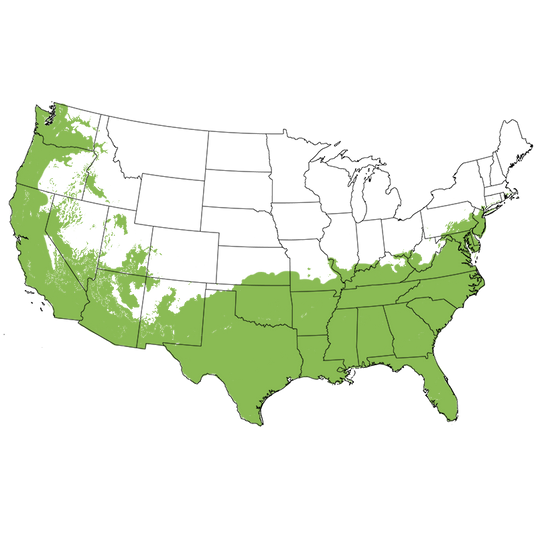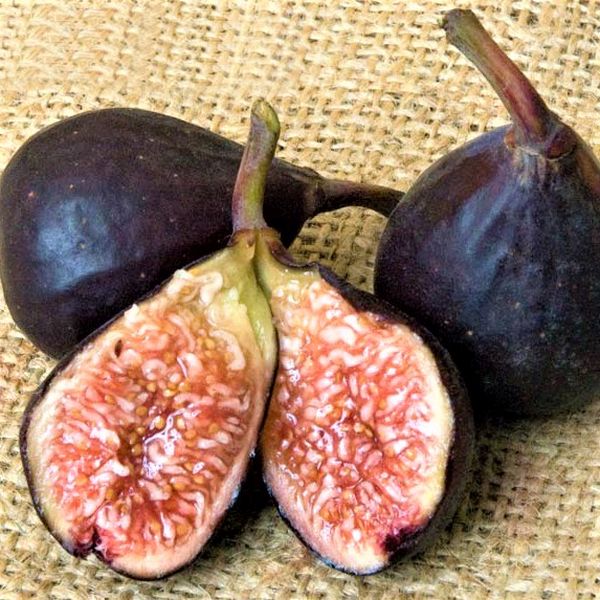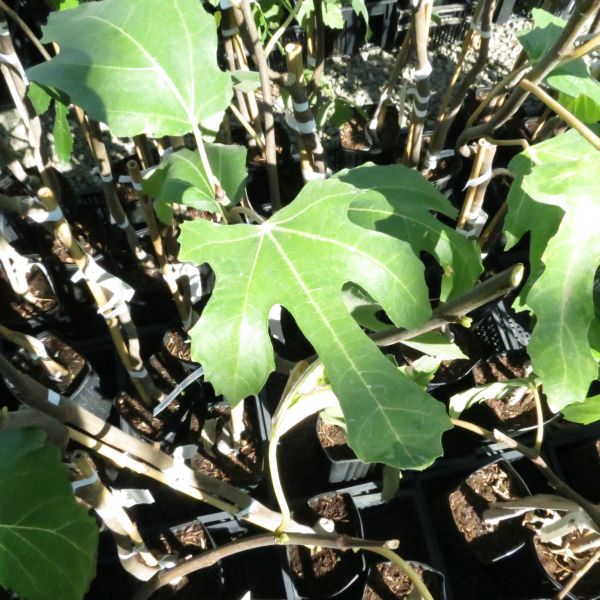Violette de Bordeaux Fig Tree
Ficus carica 'Violette de Bordeaux'
Plant Sentry™
Plant Sentry™

Plant Sentry™ Protected
Your order is protected by our compliance system that:
- Prevents restricted plants from shipping to your state
- Ensures plants meet your state's agricultural requirements
- Protects gardens from invasive pests and diseases
Delivery and Shipping
Delivery and Shipping
Delivery and Shipping
Fast, Safe Plant Delivery
Ships in 3-4 business days • Tracking provided • Weather protected
| Under $50 | $9.99 |
| $50 - $99.99 | $14.99 |
| $100 - $149.99 | $16.99 |
| $150 - $198.99 | $24.99 |
| $199+ | FREE |
✓ Zone-specific timing • ✓ Professional packaging • ✓ Health guarantee
Understanding Plant Options
Nature Hills offers plants in two main formats:
- Container Plants: Grown in pots with soil, sized by container volume and plant age
- Bare Root Plants: Dormant plants without soil, sized by height measurements
Container Plant Sizes
Container sizes indicate plant age and growing capacity rather than liquid volume equivalents. Our containers follow industry-standard nursery "trade gallon" specifications, which differ from standard liquid gallon measurements.
Young Plants (6 months to 18 months old)
| Container Size | Actual Volume | Metric Equivalent |
|---|---|---|
| 2" x 2" x 3" | 0.18 - 0.21 dry quarts | 0.20 - 0.23 dry liters |
| 4" Container | 0.31 - 0.87 dry quarts | 0.35 - 0.96 dry liters |
| 4.5" Container | 0.65 dry quarts | 0.72 dry liters |
| 6" Container | 1.4 dry quarts | 1.59 dry liters |
| 1 Quart | 1 dry quart | 1.1 dry liters |
| 5.5" Container | 1.89 dry quarts | 2.08 dry liters |
Established Plants (18 months to 2.5 years old)
| Container Size | Actual Volume | Metric Equivalent |
|---|---|---|
| 2 Quart | 2 dry quarts | 2.2 dry liters |
| #1 Container | 2.26 - 3.73 dry quarts | 2.49 - 4.11 dry liters |
| 5" x 5" x 12" | 3.5 - 4.3 dry quarts | 3.85 - 4.74 dry liters |
Mature Plants (2-4 years old)
| Container Size | Actual Volume | Metric Equivalent |
|---|---|---|
| #2 Container | 1.19 - 1.76 dry gallons | 5.24 - 7.75 dry liters |
| #3 Container | 2.15 - 2.76 dry gallons | 8.14 - 12.16 dry liters |
Large Plants (3-5 years old)
| Container Size | Actual Volume | Metric Equivalent |
|---|---|---|
| #5 Container | 2.92 - 4.62 dry gallons | 12.86 - 20.35 dry liters |
| #6 Container | 5.25 - 6.01 dry gallons | 23.12 - 26.42 dry liters |
| #7 Container | 5.98 - 6.53 dry gallons | 26.34 - 28.76 dry liters |
Bare Root Plants
Bare root plants are sold by height from the root system to the top of the plant. Plants may exceed minimum height requirements.
Common Sizes:
- Trees: 1 foot, 2 feet, 3 feet, 4 feet, 5 feet, 6 feet
- Shrubs & Perennials: 1 foot, 18 inches, 2 feet
Important Notes
Container Volume Specifications
- Trade Gallon Standard: Our containers follow industry-standard "trade gallon" specifications established by the American National Standards Institute (ANSI Z60.1) for nursery stock
- Volume Variations: Actual soil volume may vary due to plant root systems and growing medium settlement
- Age Indicators: Container size primarily indicates plant age and maturity rather than liquid volume equivalents
Growing Conditions
- Plant size can vary based on variety and growing conditions
- Container size helps indicate plant maturity and establishment level
- Larger containers generally mean more established root systems and faster landscape establishment
Seasonal Availability
- Bare root plants are available seasonally when dormant
- Container plants are available throughout the growing season
- Specific varieties may have limited availability in certain sizes
Questions?
For questions about specific plant sizes or availability, please contact our plant experts who can help you choose the right size for your landscape needs.

Plant Sentry™ Protected
Your order is protected by our compliance system that:
- Prevents restricted plants from shipping to your state
- Ensures plants meet your state's agricultural requirements
- Protects gardens from invasive pests and diseases
Plant Profile & Growing Essentials
Deer-resistant, Disease resistant, Edible, Fragrant, and Self-pollinating
-
Botanical Name
-
Height
-
Width
-
Growing Zones
-
Sunlight
-
Growth RateModerate
-
Leaf Color
-
Pollinator Required
-
Bloom PeriodLate Spring
-
FragrantYes
-
Does Not Ship ToAK, HI, ID, MT, OR

Growing Zones 7-10
Sweet Dwarf Violette De Bordeaux Fig Tree
- Heirloom Variety Considered One of the Very Best
- Sweet Figs with Rich Flavor
- Excellent Fresh or Dried
- Purple-Black Skin and Deep Red Strawberry Flesh
- Closed Eye
- Early Breba Crop
- Main Crop in Fall
- Stays Compact
- Perfect for Container Culture or Small Spaces
- Very Productive
- Self Pollinating Variety
- Low Maintenance
- Great Choice for Coastal Areas
- Deer and Pest Resistant
Delicious fresh figs twice a year? Yes, and you'll cherish the distinctive sweet, rich flavor. Store-bought figs never taste this good.
Grow your own Fig tree for the most delectable experience. It's easy with a natural dwarf tree-like Violette de Bordeaux Fig Tree (Ficus carica 'Violette de Bordeaux').
You may hear this variety called the Negronne Fig, a historied variety that offers so much for the home gardener. Violette de Bordeaux is widely considered by experts as one of the very finest figs.
This productive variety boasts an irresistible fragrance and extremely flavorful small to medium-size fruit. Violette de Bordeaux has the darkest strawberry-red flesh of any fig.
Enjoy the fruit freshly picked or dried. Use it in gourmet recipes and impress your friends!
Violette de Bordeaux is a productive variety. You'll get two crops of juicy figs a year.
The early Breba crop comes in late spring and is borne on dormant buds from last year's old wood. New wood produces the main crop, which is harvested in fall.
Pick your ripe figs when the texture turns soft. Use a sharp pair of garden shears to snip through the stem. You can also hand-pick your crops with a gentle tug upward.
Exceptional Violette de Bordeaux performs well across a wide geographic area. It's blissfully resistant to pests and diseases.
With a closed eye, it easily tolerates high heat and humidity. You and your family will love the complex, candy-flavored taste of Violette de Bordeaux and this variety's endless possibilities.
Eat fresh picked right off the tree or spread ripe, high sugar fruit on toast for a fast and healthy breakfast. Some say it is the best jam they've ever had.
For a mouth-watering fish dinner, ditch the foil. Wrap the fish in fig leaves for cooking, instead. This will keep the fish juicy and give it a delicious, coconut flavor.
Gift yourself one or more Violette de Bordeaux natural dwarf tree and leverage it as an accent tree for a small space. It is by far one of the first choices for those desiring to grow a Fig in a container on a patio or deck.
Order your Violette de Bordeaux Fig tree ASAP.
People across the country are boosting their food security with backyard orchards. Our stock of low maintenance, hardy variety will not last long.
How to Use Violette de Bordeaux Fig Tree in the Landscape
Take up one of the most productive hobbies that you can have. Grow your own figs for incredible flavor.
Fig trees are self-pollinating, so you'll just need one for fruit production. However, partner trees will definitely boost your productivity.
Save yourself time, and order several. After you taste your first homegrown fig, you'll be back for more trees. Trust us.
If you have the room, plant them in the ground. They'll provide a wonderful garden feature, with large, tropical-looking leaves and fragrant fruit.
Create a cute mini-Orchard by planting several trees ten feet apart on center. Measure from the center of one to the center of the next.
Make it easy, and use mulch between your trees. A three-inch layer will cut down on surface evaporation and keep the roots nice and cool. Pull mulch back six inches back from the trunk.
Grow this tree in outdoor containers on your deck or balcony. Today's food gardener is all about saving space with container culture and high-density planting techniques.
Use Violette de Bordeaux figs fresh for snacking, baking and cooking. How nice to know exactly what was sprayed on your tree, and when.
Funky, deeply lobed leaves hang on light gray branches. Keep the lowest branches on to let the lush, large foliage screen out ugly views for you.
Add them to your Kitchen Garden, or create an Edible Landscape. Grow one near your kitchen door to have fresh ingredients at hand for hors d'oeuvre, smoothies, tarts and more.
#ProPlantTips for Care
Violette de Bordeaux Fig grows best in full sun. Give it at least six hours of direct sunlight a day. Morning sun is optimal, as it will quickly dry the foliage.
Prune in late spring and after the second crop in fall. Decide to grow it in a traditional goblet shape, or keep it as a shaggy, shrubby plant with lower branches.
When planting, take a bit of care with the sensitive roots. Gently place the root ball in the planting hole.
Apply an even amount of water on a regular basis. Consistency is key to avoid splitting fruit.
For container-grown fruit trees, add sharply drained soil mix. Over time, the roots become densely crowded. Study our YouTube channel to see how to improve the water penetration to the root ball. (Hint, you'll create channels through the soil and fill them with gravel.)
Figs are not a houseplant, and will need to go dormant for winter. In cold zones, bring your container Fig into an unheated garage or shed for winter protection.
Savor your homegrown fruit candy! Plant a naturally dwarfed, productive Violette de Bordeaux Fig and harvest two great-tasting crops a year.
Place your order for our expertly grown trees today!
Referred to as the “Finest of all Figs”
The Violette de Bordeaux has been referenced as far back as 1692. Confusingly, it's had at least 10 different names since the 1700's, and is now also known as the Negronne Fig. No matter what it's called, and even though it's origin is shrouded in a bit of mystery, this beloved variety continues to be hailed as the finest fig of them all.
In his renowned tome published in 1955 called Fig Varieties: A Monograph, Ira Hilgardia cites Garidel, a Frenchman writing in 1715 as saying, that "the Negronne was found in nearly every vineyard in Aix, in Southern France." And indeed, many citations of the Negronne Fig can be found throughout Southern part of France by the late 1800's. References also begin to appear in the United States in the early 1900's.
Unlike most fruit introductions in the United States back then, the Violette de Bordeaux wasn't officially launched. Instead, it simply started to appear. Negronne first came to nurseries in Niles, Chico and Fresno, California as a part of the Chiswick Collection in the early 1900's. This was soon identified as being the same variety as the Violette de Bordeaux obtained from the collection of Leroy Nickel in 1921.
As the variety became more in demand, the fact that these older examples existed also became known, even though none of these early introductions were ever tested at the California Experiment Stations. Under many different names or not identified at all, the Violette de Bordeaux had found its way to Santa Barbara where a long-established tree was discovered in 1932. An older, highly productive tree was also found in Texas - although it's fruit was frankly a bit insipid.
As a smaller, vigorous tree - half the size of other fig types - Violette de Bordeaux had broad appeal. It sets 2 crops in most areas. The fruit from old wood in the first crop of the season (called the Breba crop), is of the highest quality. The second crop is also very high quality but does require consistent heat through September and October to ripen completely.
Violette de Bordeaux is adapted to the coastal climates where is produces well, if given full sun. Very tolerant of humidity, with a "closed eye", it's a good choice for some Texas climates as well as the Southern Seaboard where it stays warm and sunny into early fall. This is a good variety into Zone 8 but does require protection in Zone 7. Violette de Bordeaux is a great fig variety for container growing. Enjoy your piece of living history!










